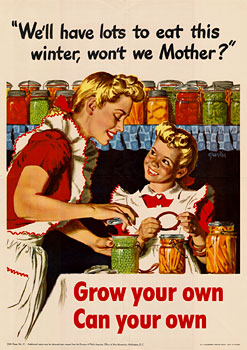
World War I poster SHSND# OWI-57The Woman’s Department had categories for Jellies, Jams, and Preserves. The earliest fairs included categories for crabapple, black currant, red currant, gooseberry, bullberry, and chokecherry, and wild plum jellies, jams, or preserves. In 1898, the superintendent added categories for canned peaches, pears, plums, raspberries, strawberries, blackberries, and blueberries. The earliest categories for jams and jellies were for wild fruits. Canning added fruits only available by purchase.
The premium books make no mention of War Gardens or Victory Gardens during the years of World War I, though there is a reference to the end of the war and a category in the Woman’s Department for Red Cross Work.
Every county, state, and multi-state fair or exposition had classes for vegetables and fruits similar to those of Morton County. Most included classes for canned vegetables and fruits, as well as jellies, jams, and pickles. Compared to the categories for livestock, field crops, and even the number of categories in the women’s division, vegetables and fruits were exhibited in two small classes in the agricultural products or horticulture divisions. Vegetables might include 40 to 60 separate categories, while fruits generally numbered 10 to 20 categories. We have no idea from the historic record how many gardeners submitted their produce for judging. The fair premium lists are generally pretty dull with few pictures and usually no color (except on the cover of the modern State Fair premium list). However, there are a few conclusions that can be drawn from these lengthy lists. Vegetables were added or removed, and the details of the categories, such as specific variety of vegetables, might tell us something about the interests of the fair board in vegetable gardening.




